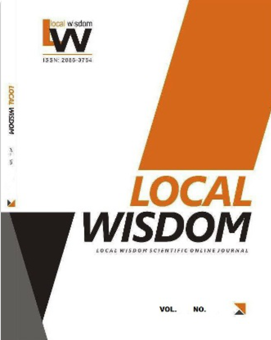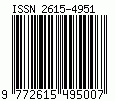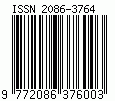Local Wisdom of Builders on The Quality of Making Concrete in Kendari City Southeast Sulawesi Province
DOI:
https://doi.org/10.26905/lw.v13i2.5565Keywords:
Building, compressive, , concrete, strength, quality, workersAbstract
In Kendari City, the concrete structure made by construction workers consists of: (a) concrete for the lower class; (b) concrete for middle society, and; (c) concrete for the upper community. The concrete is made with different sand material. This research is important to find out the method of making concrete made by construction workers in Kendari City. This research is intended to test the compressive strength and absorbency of the concrete made by construction workers in Kendari City. This study uses an experimental method with a quantitative approach. Based on laboratory test results that concrete material from 100% Unaha sand with the composition of 1 sack of cement: 4 barrel of unaha sand included in structural concrete. Concrete material from split stone and Pohara sand with a composition of 1 sack of cement: 4 barrel of Pohara sand : 4 barrel of split stone, concrete material from Unaha sand and Pohara sand with a composition of 1 sack of cement: 4 barrels of Unaha sand : 4 barrels of Pohara sand, concrete material from 100% Nambo sand with the composition of 1 sack of cement: 4 barrels of Nambo sand, concrete material from Nambo sand and Unaha sand with a composition of 1 sack of cement: 3 barrels of Nambo sand : 1 barrel of Unaha sand, and concrete material from Nambo sand and Sabulakoa sand with composition of 1 sack of cement : 3 barrels of Nambo sand : 1 barrel of Sabulakoa sand are included in non-structural concrete.Downloads
References
Abdul, N.N. (2010). Characteristics of Budel House as Gorontalo Vernacular Architecture (1890s to 1930s Era). Inovasi Journal, Vol: 7 No.1, 176-188.
Ahmad, I.A. Taufieq, N.A.S. Aras, A.H. (2009). Analysis of the Effect of Temperature on the Compressive Strength of Concrete. Teknik Sipil Journal, Vol: 16 No. 2, 63-69.
BPS-Statistics of Kendari Municipality. 2020. Kendari Municipality in Figures 2020. BPS-Statistics of Kendari Municipality: Kendari City.
Dilia, A.S. Naseerb, M.A, Zacharia, T. Varghesea. (2010). Passive Environment Control System Of Kerala Vernacular Residential Architecture For A Comfortable Indoor Environment: A Qualitative And Quantitative Analyses. Energy and Buildings Journal, Vol: 42, 917–927.
Erdiono, D. (2011). Modern (Neo) Vernacular Architecture in Indonesia. Sabua Journal, Vol: 3 No. 3, 32-39.
Hidayatun, M.I. (2008). The essence of space in traditional architecture as an answer to the challenges of nature. In Proceeding of the National Seminar on Exploring Traditional Archipelago Architecture in Identifying Technology Based on Local Wisdom. Makassar. Center for Research and Development of Settlements, 1-11.
Jeraman, P. (2008). NTT Vernacular Architectural Transformation in Kiwari Architectural Design. In Proceeding of the National Seminar on Exploring Traditional Archipelago Architecture in Identifying Technology Based on Local Wisdom, Makassar Center for Research and Development of Settlements, 1-17.
Manuahe, R., Sumajouw, M.D.J. Windah, R.S. (2014). Compressive Strength of Fly Ash Based Concrete Geopolymer. Sipil Statik Journal, Vol: 2 No. 6, 277-282.
Oliver, P. (2005). Encyclopedia of Vernacular Architecture of The World. Cambridge University Press: Cambridge.
Rapoport, A. (1969). House Form and Culture. Prentice Hall: New York.
Philokypro, M. (2015). Continuities and Discontinuities in the Vernacular Architecture. Athens Journal of Architecture, Vol: X No. Y, 1-10.
Rengkung, J. (2011). Vernacular Architecture of Minahasa Ethnic Community Residential Homes. Media Matrasain Journal, Vol: 8 No. 3, 12-24.
Sahroni, A. (2012). Indonesian Vernacular Architecture: Role, Function, and Preservation in Society. Puslitbang Arkenas-academia.edu, 1-9.
Salain, I.M.A.K. (2007). Comparison of Compressive Strength and Permeability of Concrete Using Portland Pozzolan Cement Using Type I Portland Cement In Seminar and Exhibition of HAKI-Earthquake Resistant Construction in Indonesia, 1-6.
Suarnita, I.W. (2011). Compressive Strength of Concrete with Additive Fly Ash Ex. PLTU Mpanau Tavaeli. Smartek Journal, Vol: 9 No. 1, 1-10.
Suseno, H. Wahyuni, S.E., Hariono, B. (2008). The Effect of Mixed Proportion Variation and Superplasticizer Addition on Slump, Fill Weight and Compressive Strength of Aggregated Structural Lightweight Concrete andesite Pyroxene Stones. Rekayasa Sipil Journal, Vol: 2 No. 3, 241-253.
Turan, M. 1990. Vernacular Architecture Gower. Publishing Company Old: USA, Vermont.
Umar, M.Z. (2016). Sloof and Identification of Local Wisdom among Construction Workers. Vokasi Indonesia Journal, Vol. 4 No. 1, 92-102.
Umar, M., Z, Arsyad, M. (2016). Knowledge Coexistence Between Builders and Educated Architects Regarding Sloof. In National Seminar on Nusantara Architecture 4, 1671-69.
Umar, M.Z. Faslih, A. Arsyad, M. Sjamsu, A.S. Kadir, I. (2017). Building Structure Housing: Case Study of Community Housing in Kendari City. Materials Science and Engineering Journal, Vol. 267 No. 1, 1-6.
Wahid, A. (2012). Adaptive Vernacular Options for Sustainable Architecture. Journal of the International Society for the Study of Vernacular Settlements (ISVS e-journal). Vol: 2 No. 2, 74-87.
Widyawati, R. (2011). Study of the Compressive Strength of Lightweight Concrete Using the Dreux-Corrise Mix-Design Method. Rekayasa Journal, Vol: 15 No. 1, 40-41.
Zubaidi, F. (2009). Kaili Architecture as a Vernacular Process and Product. Ruang Journal, Vol: 1 No. 1, 27-37.












